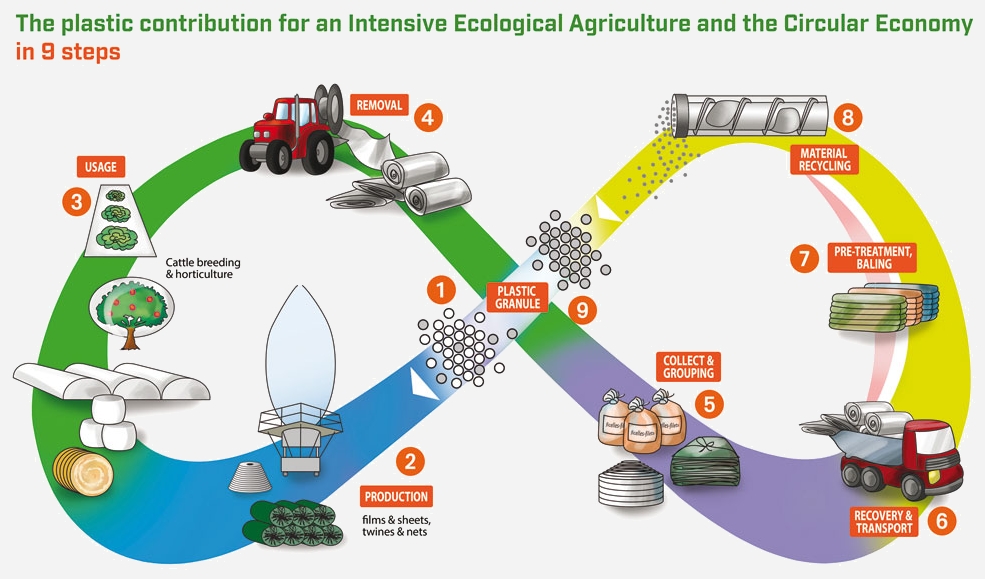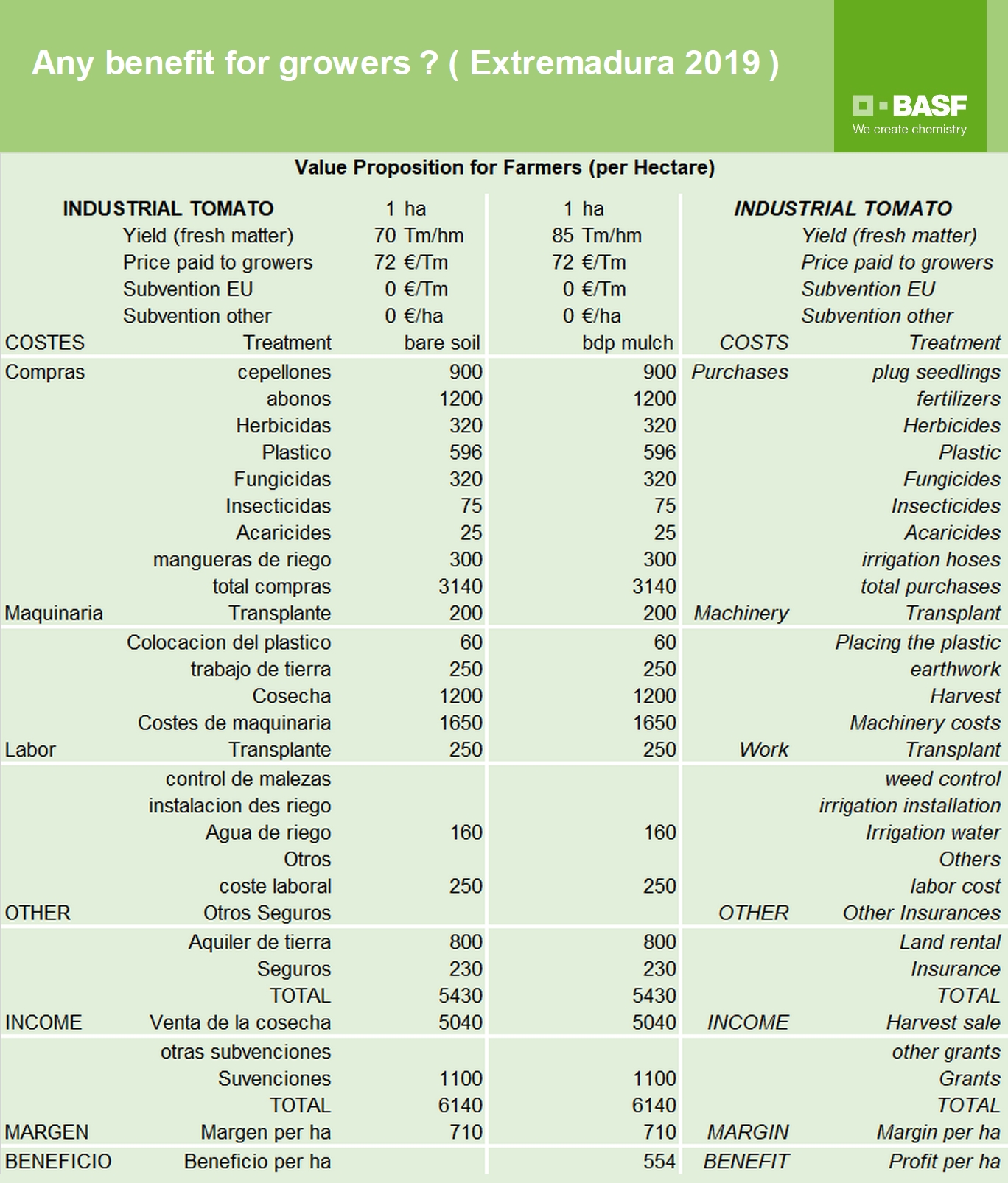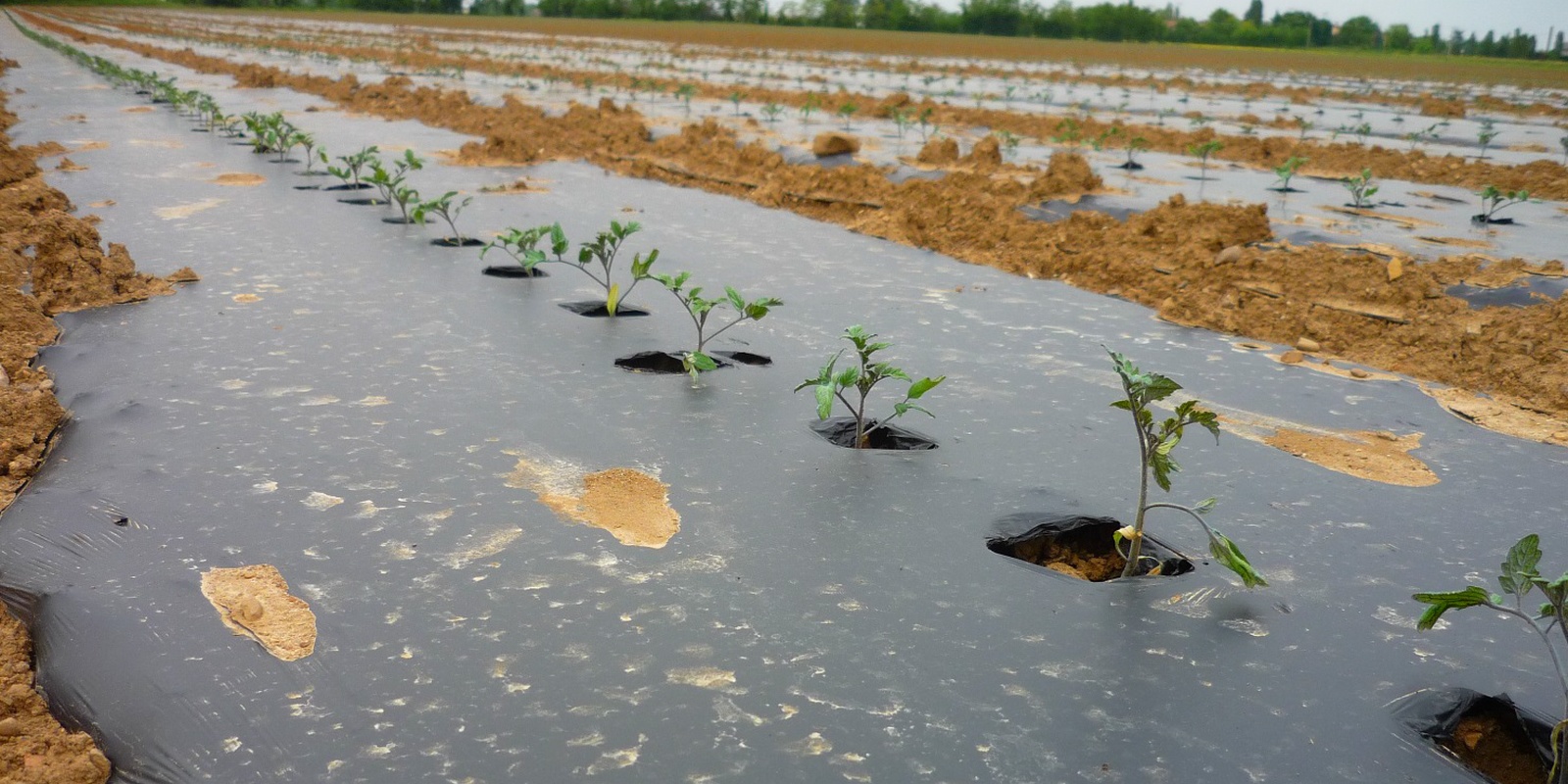(Part 2)
 Impact on yield:
Impact on yield:In a report entitled "Effects of biodegradable mulch on weed control" in 2010, Anzalone et al in Zaragoza reported a statistically significant difference in three-year field trials (2005/2008) of +216% (based on 35.5 mT/ha for bare soil) and 290% (95.2 mT/ha for mulched plants). It is difficult to explain such differences; these results were obtained from a single trial, with small elementary plots. However – and this is a common argument in commercial practice – mulch films are considered to give an additional yield of about 15%. This value is generally incorporated into profitability calculations.
 Harvest quality:
Harvest quality: It has been observed on many occasions by growers and technicians that the harvest from a mulched plot is less damaged and healthier than when the fruits are in contact with the soil. It is also sometimes appreciated and valued by processors, who receive cleaner deliveries of raw materials.
 Earliness:
Earliness: Gains of 10 to 15 days on average are most frequently mentioned by growers and processors. Factories can then work for a longer period, thereby compensating for the additional investment cost compared to growing without mulching.
 Weed control:
Weed control:
The study by Anzalone et al (2010), initially devoted to this particular point, demonstrated a reduction in the dry weight of weeds in the case of biodegradable mulch compared to the result obtained on bare soil. As such, it is important to note that biodegradable films, by their ability to limit the development of weeds, can provide a solution to the challenge represented by the probable ban after 2020 in the EU of fluorochloridone, the active ingredient of the "Racer Me" anti-germination herbicide.
No information has been reported regarding the impact on irrigation, but it is conceivable that strong competition for water usually occurs between the tomato plants and the weeds present, so a reduction in the presence of weeds would have the double advantage of facilitating the crop's access to water and reducing demand (and thereby reducing irrigation input).
 Water saving:
Water saving:
Simple observations reported by growers show that water saving can be seen visually due to reduced evaporation, although greater canopy development at the start of cultivation can induce higher transpiration, as reported by Cosme Argerich (INTA, National Institute of Agricultural Technology) in Argentina. The most frequent figures found in the relevant literature consider that the water saving is around 20 to 30% with mulch films compared to cultivation in bare soil.
 Economic impact:
Economic impact:Experts in the sector estimate that the gains can reach 10 to 15% in terms of improved agricultural yields, up to 10 or 15 days in terms of earliness and up to 20 or 30% in terms of reduction in water expenditure (excluding the implementation of micro-irrigation). The ultimate advantage of biodegradable mulching is that the operator does not have to deal with collection operations, which are compulsory with traditional mulching, the cost of which (labor, equipment, etc.) represents up to 40% of the total cost of use. The price per tonne of biodegradable mulch film is three or four times higher than that of conventional film. However, the thicknesses used in cultivation (20µ to 25µ for conventional film, compared to the current 12µ for standard biodegradable film, sometimes even 8µ or 6µ for certain applications) reduce the costs of using biodegradable mulches to levels compatible with large industrial crops.
The following data comes from direct discussions with growers at an open day for producers and technicians from Extremadura.
Europe: voluntary schemes and legislation
Given the economic and environmental challenges linked to this segment of agricultural activity, the European Union is studying the advisability of legislating on agricultural plastics as it has done on packaging plastics. It has involved professional associations in its discussions, in particular APE Europe (Agriculture, Plastics, Environment Europe), whose activities in several European countries aim to promote the collection and recycling of used plastics. In about ten European countries, specifically dedicated systems already exist (France, Germany, Ireland, Iceland, Norway, Sweden, Belgium, Luxembourg) or are in the start-up phase (Spain and United Kingdom). In France, the most advanced European country on the subject, films, strings, nets, anti-hail protection nets and flexible irrigation ducts are collected, with studies in progress to integrate anti-insect nets and non-woven films used against frost conditions.

The stakeholders of these voluntary approaches wish to preserve the current dynamic by asserting the preeminence of the tangible results obtained by the profession (75% collection rate and 80% recycling rate at the start of 2020 in France, for example) over "political" objectives considered by the legislator. At a time of "plastic bashing", with European citizens expressing concern about the future of the planet and the food supply of a growing population, public authorities all over the world are getting involved through laws and regulations in addressing the negative environmental impact of plastic. European plasticultors have been aware of this situation for a long time, and they have been contributing for more than 20 years to the implementation of solutions in their field of expertise, that of plastics used in agriculture. The sustainability and competitiveness of agricultural production, as well as the environment and economic activity are all at stake.
APE Europe, the voice of European plasticultors
After the publication of the European Plastics Strategy, published in January 2018, followed by the Directive on single-use plastics, the European Commission launched the work of the Circular Plastics Alliance (equivalent to the Roadmap of the European Circular Economy Action Plan), which aims to integrate 10 million tonnes of PCr ("post consumer recycled", made from used plastics) into new products. It is now looking into the issue of plastics used in agriculture, carbon footprints, impact on soils, end-of-life management, and the value of biodegradable products. APE Europe (the European professional association which represents 80% of the market) was created specifically to take these subjects into account and share them with as many people as possible.
APE Europe manufacturers consider it their responsibility to develop, apply and disseminate as widely as possible solutions for a neutral plastic assessment for users. This is the reason why, in 2020, EPA Europe is publishing "The European Strategy for Plasticulture" in order to share its experiences and its objectives. This document, based on the results already obtained by European plasticultors in terms of collection, recycling and incorporation of recycled plastics in their products, also aims to provide those responsible for public policies with the references and elements of assessment necessary to establish a legislation adapted to the specific nature of agriculture. Indeed, existing European experiences in a voluntary framework often yield results beyond even the desired objectives. They meet the requirements of the legislation, within the framework of the extended producer responsibility (EPR) that is shared between the economic players: farmers, distributors and processors. However, there are still areas where, in the absence of a long-term organization of collections, farmers do not yet have access to the services of a collection system that permanently manages their used agricultural plastics. The impending new legislation should seek to resolve this issue by involving all the stakeholders in running the scheme.
Sustainable agriculture and efficient food production
Many farmers worldwide have used padded polyethylene (PE) films in the cultivation of industrial tomatoes, the most cultivated vegetable in the world, to increase yields, as they allow the control of weeds, soil temperature, and water consumption. However, although padded films should be removed from the surface at the end of the harvest, it was often impossible to remove them completely and, as they were not biodegradable, the excess particles accumulated in the soil.
To solve this problem, BASF is offering tomato growers a biodegradable plastic for quilted films made with ecoflex® polybutylene adipate-terephthalate (PBAT) and other biodegradable polymers obtained from renewable raw materials. This new material not only increases the yield of horticultural crops between 15% and 50% but – since it is biodegradable – it also leaves no contaminating residue. In addition to reducing water consumption and improving weed control, this material allows the crops to be more resistant against fungal diseases, enables earlier harvesting, and achieves better quality and a higher Brix index, while being more homogenous. Therefore, sustainable agriculture can go hand-in-hand with efficient food production, with higher yields and high quality.
A study by ETH Zürich, from Switzerland, has shown that plastics made with PBAT serve as food for soil microbes such as bacteria and fungi. This means that the PBAT degrades in a natural way and, unlike PE, it disappears from the soil. Consequently, the biodegradable padded films that remain in the soil contribute to improving the quality of the soil, the development of roots, and the plants' growth. This material is the first material certified as biodegradable in the field according to the European standard DIN EN 17033. The use of such padded films is also accepted in organic farming in many countries.
"We offer our support to farmers in many countries to use quilted films made from this material," stated Dirk Staerke of the Department of Marketing of Biopolymers for Agriculture at BASF.
"According to the FAO, until 2050 world agricultural production must increase by 70% in order to feed a population that, by then and according to forecasts, will have reached 9 000 million people. Biodegradable plastics can help overcome this challenge without leaving contaminant residues on the ground."
The Tomato News editorial team wants to thank Mr. Olivier de Beaurepaire, agronomist for BASF France in charge of the CIPA technical committee for biodegradables, and Mr. Xavier Ferry, of the International Committee for Plastics Used in Agriculture (Assistant to the General Secretary), for their help in providing documentation and assistance in writing this article.
Some complementary data

































